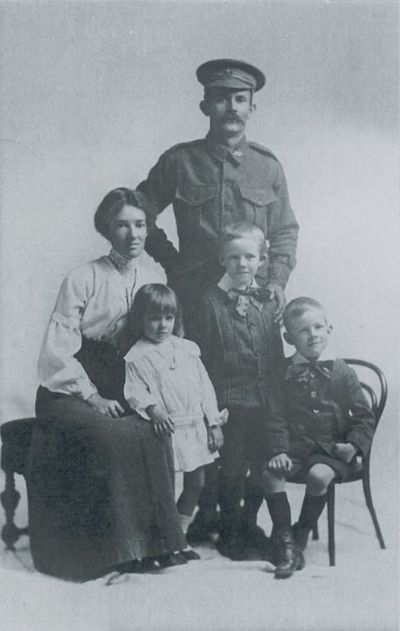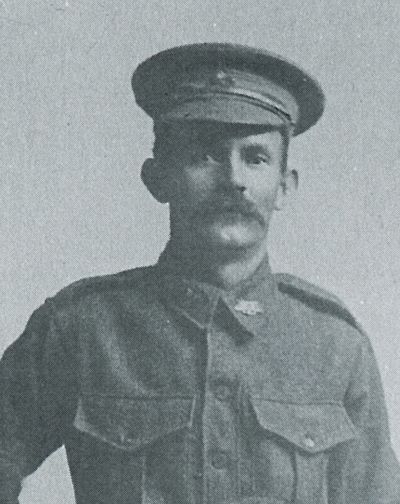Charles Fancote
From Our Contribution
 Courtesy Colleen Fancote | |
 | |
| Personal Information | |
|---|---|
| Date of Birth | 11 Sep 1875 |
| Place of Birth | Kelmscott, Western Australia |
| Death | 4 Sep 1926 |
| Place of Death | Kelmscott, Western Australia |
| Age at Enlistment | 40 years, 6 months |
| Description |
5'7¼" (1.71m) tall ; 130 lbs 58.967 kg ; fresh complexion ; brown eyes ; brown hair |
| Occupation | Road Board employee |
| Religion | Church of England |
| Address | Kelmscott, Western Australia |
| Next of Kin | Wife , Mrs Mary Irene Fancote |
| Military Information | |
| Reg Number | 6512 |
| Date of Enlistment | 17 Aug 1916 |
| Rank | Private |
| Unit/Formation | 16th Battalion, 21st Reinforcement / 4th Brigade, 4th Division |
| Date of Embarkation | 13 Oct 1916 ‒ 12 Dec 1916 |
| Ship Embarked On | HMAT A39 Port Macquarie Fremantle to Plymouth |
| Date of Return | 31 Jan 1918 ‒ 6 Apr 1918 |
| Ship Returned On | RMS Osterley England to Fremantle |
| Fate |
Wounded in Action 28 Sep 1917 at Menin Road Returned to Australia |
| Monument | Kelmscott War Memorial (West panel) |
| Medals |
British War Medal Victory Medal |
For the grave at Saint Mary-in-the-Valley cemetery, see Charles_Fancote_(St_Mary-in-the-Valley)
Pre War
1903 - 1906 Electoral Rolls lists him as a labourer, Kelmscott; 1910 - 1916 a mill hand with Mary Irene (nee Watson) who he married on 26 Jan 1908 in Leederville.
War Service
On entering camp, Charles was initially allocated to the 63rd Depot Company. Two weeks later, Charles was allocated to the 21st reinforcement draft for the 16th Battalion, travelling with them to England.
In England he entered the 4th Infantry Training Battalion at Rollestone on 12 Dec 1916 where he completed his training prior to proceeding to France on 29 May 1917 via Southampton.
Charles spent from 30 May to 19 Jun 1917 in the 4th Division's Base Depot in France before he joined 16th Battalion on 21 Jun 1917, a time when they were training in bayonet fighting, and gas drills while making repairs to local roads. On 29 Jun 1917 they entered the front line south of Ypres, north of Ploegsteert, near Neuve Eglise in Belgium. Later in September they were in the front line adjacent to Ypres itself. On the night of the 28 Sep 1917 the 16th Battalion was relieved in the front line by the 48th Battalion, so Charles' wound was most likely caused by shrapnel from artillery responding to the movement of the men to and from the front line.
He received a shrapnel wound to his lower abdomen, causing debility for a considerable time. Treated by 47th Casualty Clearing Station and the 7th Canadian General Hospital at Étaples before being shipped to England and admitted to the 1st Birmingham War Hospital on 12 Oct 1917. Charles was granted furlough from 7 - 21 Dec 1917, and then spent time in the 2nd Convalescent Depot Weymouth from 22 Dec 1917 until 13 Jan 1918. He then reported to No.4 Command Depot at Hurdcott on 14 Jan 1918 for assessment, and then to the No 2. Command Depot Weymouth later the same day.
Given the severity of his wounds, and his age (42), he was quickly shipped back to Australia as there was no chance of him re-entering the field. His return was via Capetown. On arrival in Fremantle Charles was admitted to the 8th Australian General Hospital from 6 - 15 Apr 1918. Charles was discharged on medical grounds by the 5th Military District on 29 Apr 1918.
Following Charles' discharge, Mary Irene received a pension of 20/- fortnightly, Edward Charles (son) 13/3 per fortnight, Albert George (son) 10/- per fortnight, Dorothy May (daughter) 6/6 per fortnight, and Charles himself 40/- per fortnight from 30 Apr 1918.
Post War
Electoral Roll entries - 1921 and 1925 a mill hand in Kelmscott; Mary in 1931 to 1958 at 'Arnagill House', Kelmscott. Mary died 8 Apr 1959, aged 77 in Roleystone where she lived with her daughter and son-n-law Dot & John Parkin.
Notes
Reference
External Links
- AIF Project
- RSL Memorial[[Category:Born Australia]